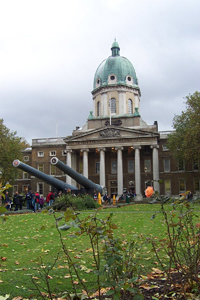Material Culture and 20th Century War
Paul Cornish (Dept of Exhibits &
Firearms, Imperial War Museum, IWM).
Nicholas J. Saunders (Dept of Anthropology, University
College London, UCL).
Anthropologists have long been interested in war, though hitherto the study of twentieth century conflict has relied overwhelmingly on military history's accounts of events, and the economic, social, and political historians views of the consequences. Apart from an art historical interest in war painting, and a broader concern with post war commemorative monuments, an anthropological focus on the materiality of conflict has been virtually absent.
As first-hand memory of the 20th century's major conflicts fades, our view of these events is increasingly determined by interpretations of material culture by those who were not concerned with its production and original purpose. Here, the multi-disciplinary approach of material culture studies comes into its own, offering new ways of investigating industrialized war at a personal and cultural level and on a regional as well as global scale. The fact that modern conflicts are defined by their technologies as wars of matériel is a clear invitation for such an approach. Today, there is an urgent need for an explicitly anthropological/archaeological approach to modern warfare as part of a wider re-evaluation of the role of material culture in war.
Material Culture of War
War is the transformation of matter through the agency of destruction, and industrialized conflict creates and destroys on a larger scale than at any time in human history. Modern war has an unprecedented capacity to re-make individuals, cities, nations and continents. The immense production of material culture during industrialized conflict embodies and provokes the extremes of human behaviours.
An anthropological focus sees objects as possessing important and variable social dimensions beyond, as well as including, their original design purpose. Objects embody an individual's experiences and attitudes as well as cultural choices in the technology of production. They occupy a dynamic point of interplay between animate and inanimate worlds, inviting us to look beyond the physical world and consider the constantly changing relationships between objects and people. Such objects may be small, e.g. a bullet, intermediate, e.g. a tank, or large, e.g. a whole battlefield landscape. All are the product of human action rather than natural processes. Thus, the Western Front of the First World War is as much an artefact as a portable war souvenir, a Second World War V2 rocket, or the 'Cross' formed by remaining structural elements in the ruins of the World Trade Centre.
 Seeing
the world in this way allows us to explore the 'social
lives' of these objects by assessing the changing values
and attitudes attached to them by different people over
time. The features of war, like any artefacts, embody
a diversity but perhaps a unique intensity of individual,
social and cultural ideas and experiences. Illustrating
this point is the change in attitudes in Britain towards
the commemorative association of war memorials, Armistice
Day parades, and the observance of two minutes silence
from 1919 to the present. Here, materiality, spirituality,
politics and emotion link the living with the dead in
a complex interplay of past and present.
Seeing
the world in this way allows us to explore the 'social
lives' of these objects by assessing the changing values
and attitudes attached to them by different people over
time. The features of war, like any artefacts, embody
a diversity but perhaps a unique intensity of individual,
social and cultural ideas and experiences. Illustrating
this point is the change in attitudes in Britain towards
the commemorative association of war memorials, Armistice
Day parades, and the observance of two minutes silence
from 1919 to the present. Here, materiality, spirituality,
politics and emotion link the living with the dead in
a complex interplay of past and present.
The transformational power of industrialized war is evident at every scale of human activity, and can be tracked through various objects and across disciplinary boundaries. The investigation of objects known as 'trench art' (3-D items made by soldiers and civilians between 1914 39 as mementoes, souvenirs, and memory objects) illustrates how the analysis of one kind of war related objects can initiate a new kind of debate on the nature of war. What, we might ask, are the implications for assessing the 'social life' of First World War memorabilia displayed as memory objects in the home for eighty years, identical items stored and/or exhibited in museums, and similarly identical materials excavated from Great War archaeological sites some of which then feed and stimulate the international trade in military collectables? The making and decoration of trench art objects attach people to these items, revealing their untold experiences of conflict.
Significantly, these objects are often found (as tourist items and archaeological materials) in the battlefield landscapes in which they originated. In one sense, objects and landscapes merge in the individual's experience of 'being in' a place that is both real and imagined. During the inter-war years, many such items were bought by the bereaved, transported from the landscape of battle to the intimacy of the home where they were displayed, mediating grief and loss in ways which have so far not been investigated.
Human beings are defined by their technologies, and nowhere are these more insistent than in modern wars and their seemingly interminable aftermaths. As anthropology and archaeology begin to engage with these issues, the possibilities of future inter disciplinary approaches to conflict are becoming clear.
Material Culture and the Imperial War Museum
 The
Imperial War Museum’s terms of reference charge
it with collecting material relating to all conflicts
since 1914 involving British or Commonwealth forces. As
a consequence the breadth of its collections is unrivalled,
encompassing documents, photographs, film, sound recordings
and works of art, in addition to the more obvious three-dimensional
examples of material culture. It is notable that, from
the day of the museum’s establishment in 1917, much
emphasis was placed on collecting objects with interesting
provenance. Furthermore, the founders of the museum were
determined to make its collections relevant to the individual,
and to acquire items redolent of the involvement of the
common man and woman in the war, whether at the Front
or at home.
The
Imperial War Museum’s terms of reference charge
it with collecting material relating to all conflicts
since 1914 involving British or Commonwealth forces. As
a consequence the breadth of its collections is unrivalled,
encompassing documents, photographs, film, sound recordings
and works of art, in addition to the more obvious three-dimensional
examples of material culture. It is notable that, from
the day of the museum’s establishment in 1917, much
emphasis was placed on collecting objects with interesting
provenance. Furthermore, the founders of the museum were
determined to make its collections relevant to the individual,
and to acquire items redolent of the involvement of the
common man and woman in the war, whether at the Front
or at home.
Also inherent in the original conception of the museum was a wish to create a national war memorial. Financial considerations soon put paid to grandiose schemes of this sort. However, it is evident that many exhibits swiftly acquired memorial significance. Records of early Armistice Day ceremonies make this abundantly clear. Typically, the two-minute’s silence would be signalled by ringing the bell of HMS Implacable and brought to an end by a call on a bugle which had been used at the Battle of Loos in 1915. The public would then be invited to lay wreaths and floral tributes on “certain exhibits of outstanding importance”. In 1924 these comprised: a 13 Pounder Gun associated with the winning of 3 Victoria Crosses by “L” Battery, Royal Horse Artillery in 1914; a howitzer fitted to HMS Vindictive for the Zeebrugge raid of 1918 and the top of the original Cenotaph (a temporary wooden structure, replaced by the current Cenotaph in 1920). Such practices failed to survive the changing political climate of the nineteen-thirties. The recent return to observation of the two-minute’s silence at 11.00 on 11 November has found strong support among visitors to the museum, although the guns are no longer a focus of memorialization. Today this sort of significance is more likely to be invested in personal objects, such as the “trench art” made by men at the Front, or the pathetic remnants of the possessions of victims of the Holocaust.
Memorialization is just one of many strands which constitute the way in which the museum’s collections are viewed. The “social life” of objects means that, over the years, they gather many layers of significance. First and foremost, they help to form the way in which we perceive the conflicts of the Twentieth Century. In this role, certain objects have gained “iconic” status. Some were produced with this very intention in mind – for instance the Victoria Cross. Other, humbler, items have become icons because they are perceived as symbols of the events that produced them. For example, no display concerning the British Home Front of the Second World War would be considered complete without an ARP warden’s helmet and a child’s “Mickey Mouse” respirator.
Some things were created or collected to propagate certain views about the conflicts from which they emerged. Propaganda material, as well as most film and photographs and works of art, are, from the moment of their creation, purely subjective in their treatment of events. Less obvious objects play a similar role. Witness for instance the 5.5 inch naval gun at which sixteen year old Jack Cornwell won a Victoria Cross at the Battle of Jutland. This was acquired as a symbol of an act of heroism and devotion to duty that was held up as an example to generations of schoolchildren. While we may now look with a jaundiced eye upon the excesses of wartime propaganda, or have doubts about the patriotic myths woven about boy-heroes, this simply means that we are still interacting with these examples of material-culture – their “social life” continues.
The Imperial War Museum is an invaluable repository of war-related material-culture, which repays study on a number of levels. Firstly, in purely practical terms, items may be of interest as examples of technology or art; or may serve as pieces of historical evidence. Secondly, they represent the ways in which people interacted with and responded to the material aspects of wartime life. Finally, much can be learnt from the constant fluctuations in the significance and meaning of these things, as seen through the mediation of the philosophical, cultural and political changes that have taken place since they were produced. It is somehow fitting that the museum began its collecting in the midst of a war which was to change forever the way in which wars were perceived.
Future reading
The following book emanates from a joint conference held by UCL and IWM in 2002 and is due out next year:
Materialities of Conflict: Anthropology and the First World War, (ed.), Nicholas J. Saunders, Routledge, 2003.

